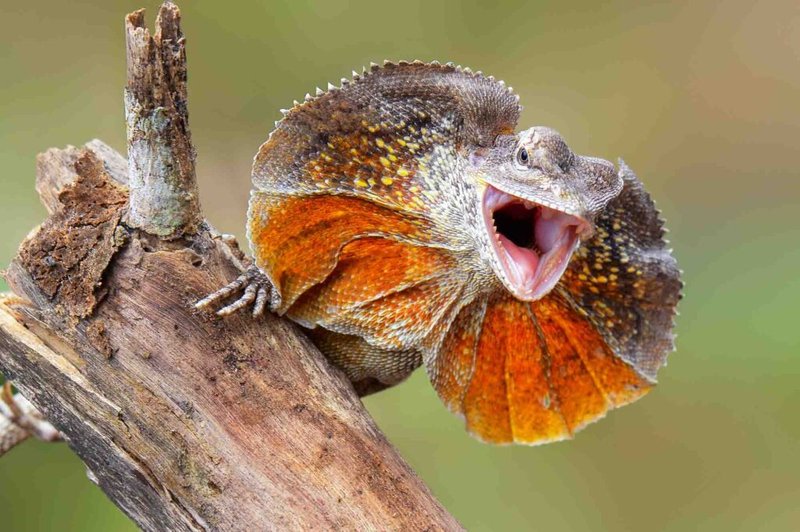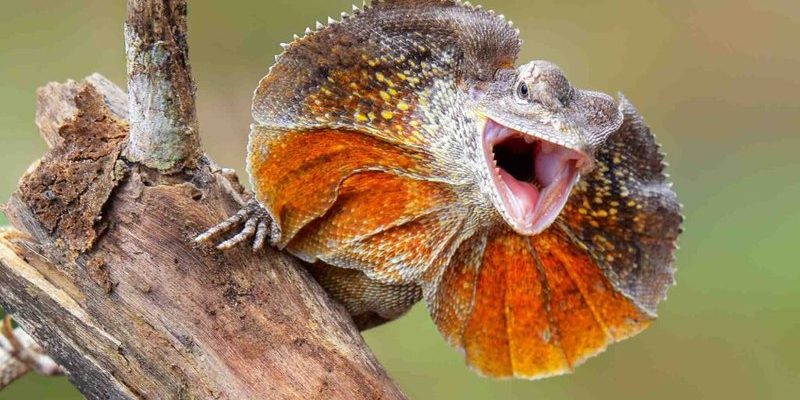
The frilled lizard, often seen in nature documentaries showing off its impressive frill when threatened, is native to the woodlands of Australia and New Guinea. Known for its unique ability to flatten its neck and open a stunning frill, this lizard captures attention and curiosity. But beneath that dramatic exterior, the frilled lizard faces threats that could put its future at risk. So, what’s the scoop on its conservation status?
The Current Status of the Frilled Lizard
The frilled lizard is classified as “Least Concern” by the International Union for Conservation of Nature (IUCN). This might sound like a relief, but let me explain what that actually means. Being listed as “Least Concern” doesn’t mean it’s free from danger. Instead, it indicates that, for now, the species isn’t facing an immediate threat of extinction. However, this status can change as environmental factors evolve.
Despite this classification, populations of frilled lizards are declining in some areas due to habitat loss and human activities. As forests are cleared for agriculture or urban development, these lizards lose their homes, much like any creature would. It’s important to keep an eye on their situation, as changes in their habitat quality can lead to significant declines in their numbers over time.
Additionally, frilled lizards are sometimes captured for the pet trade, which can further stress local populations. While they are fascinating pets for enthusiasts, removing them from their natural habitat can disrupt the ecosystem balance. So, while they aren’t endangered right now, it’s like holding a delicate vase—just one wrong move could change everything.
Challenges Facing Frilled Lizards
The threats to frilled lizards are multifaceted and stem mainly from human actions. One of the biggest challenges they face is habitat destruction. Think of it like this: if you’re constantly moving from your home because your neighborhood is being torn down, it’s tough to settle down and thrive.
– Deforestation: The clearing of forests for timber, agriculture, or urban sprawl leads to a loss of shelter and food for these lizards. Without the trees and underbrush they rely on, they struggle to survive.
– Environmental Changes: Climate change also poses serious risks. Changes in temperature and rainfall patterns can affect their habitats, leading to droughts or flooding that can eliminate their food sources.
– Pet Trade: While some might want a frilled lizard as a pet due to their unique appearance, taking them from their natural environment can harm their populations. It’s essential to consider ethical sourcing if you’re ever thinking about adopting one.
Conservation Efforts in Action
So, what’s being done to help protect the frilled lizard and its habitat? Here are a few key conservation efforts that are currently underway:
– Protected Areas: Organizations are working to establish and maintain protected habitats where these lizards can live without the threat of habitat destruction. These areas become safe havens, allowing the lizard populations to recover.
– Awareness Campaigns: Educating the public about the importance of preserving habitats is crucial. The more people understand how their actions impact wildlife, the more likely they are to support conservation initiatives.
– Legislation: Laws regulating the trade of wild reptiles help to deter illegal capture and trade. This legislation can protect not just frilled lizards but many other species facing similar threats.
– Community Involvement: Involving local communities in conservation efforts can make a significant difference. When people are educated and see the value in their local wildlife, they become advocates for preserving it.
The Role of Individuals in Conservation
You might be thinking, “What can I do?” and that’s a great question! Everyone has a role to play in conservation, even if you’re not a scientist or activist. Here are some simple ways you can contribute to protecting the frilled lizard and other wildlife:
- Educate Yourself: Knowledge is power. Learning about the frilled lizard’s habitat and threats can make you a better advocate for their protection.
- Support Conservation Organizations: Donating or volunteering with groups focused on wildlife preservation can help fund critical initiatives.
- Practice Responsible Pet Ownership: If you decide to get a lizard as a pet, make sure you adopt from a reputable source. Never capture a wild one.
- Reduce Your Carbon Footprint: Simple changes in your daily life can help combat climate change. This includes using less plastic, conserving energy, and supporting sustainable products.
It’s clear that while the frilled lizard isn’t currently endangered, its future is uncertain. Habitat loss, climate change, and the pet trade are significant threats that can quickly change the lizard’s status. But there’s a silver lining: by being aware of these issues and taking action—whether it’s supporting conservation efforts, educating ourselves, or practicing responsible ownership—we can make a difference.
The frilled lizard is a remarkable creature that contributes to the rich tapestry of biodiversity on our planet. Let’s ensure it continues to thrive for generations to come, not just for its quirky frill but for everything it represents in the delicate balance of nature. Each small effort counts, and together, we can help protect these fascinating lizards and their habitats.

